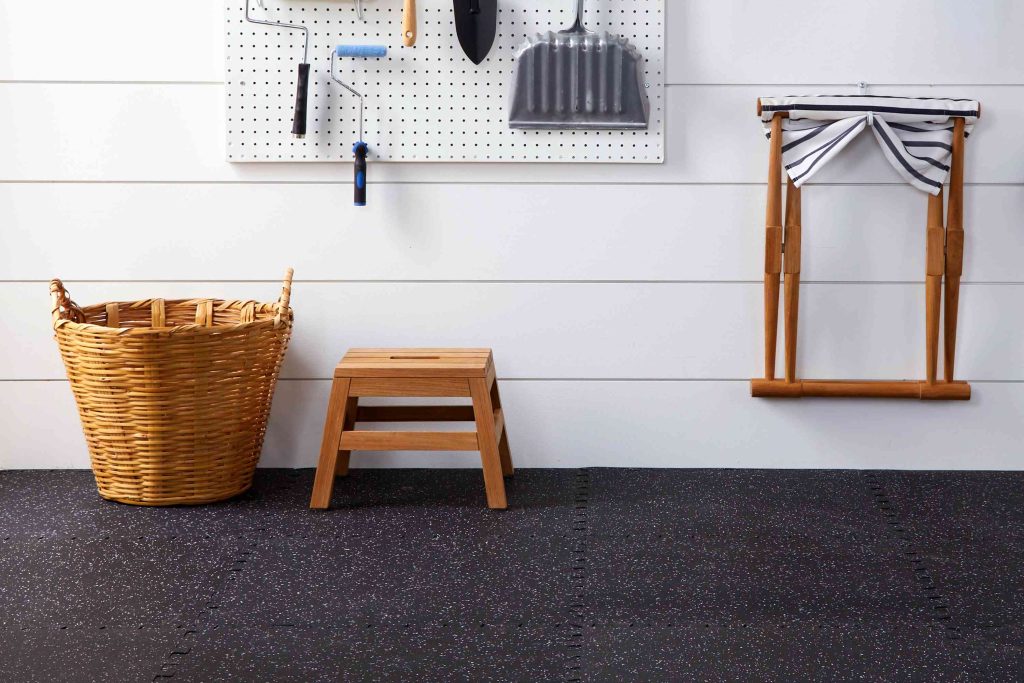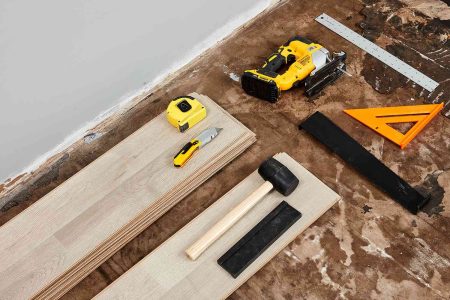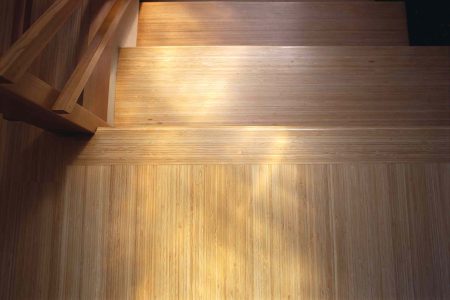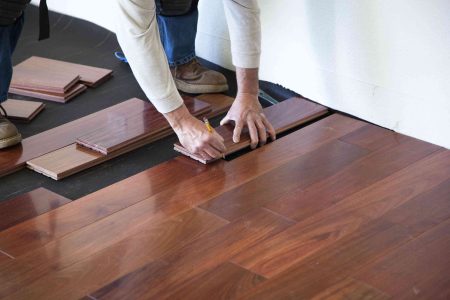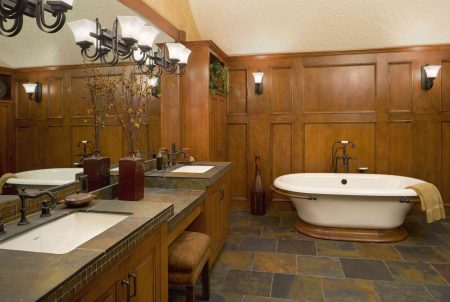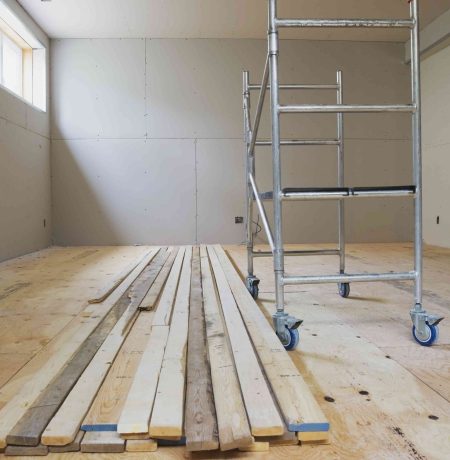Rubber is a versatile, durable, and ecologically friendly flooring option that’s suitable for many rooms in the house, but its performance characteristics make it particularly well-suited to basement environments. While rubber flooring does have a few drawbacks that you should be aware of, overall it is a safe, long-lasting material that can handle the water, mold, stains, and humidity that can be present in the below-grade world of the basement.
Rubber flooring is available in two types: sheets that are rolled out and cut to fit the shape of the room, and interlocking tiles that are placed down on the subfloor in whatever pattern you like. Interlocking tiles are especially friendly to DIYers. No adhesives are required; the tiles simply lay on top of the concrete slab subfloor.
Rubber Flooring in Basements
-
Resists moisture
-
Discourages mold
-
Easy DIY installation
-
Good durability, easy maintenance
-
Comfort and safety
-
Eco-friendly material
-
Lacks stylishness
-
Relatively expensive
-
Prone to oily stains
-
Smelly when new
Advantages of Rubber Flooring for Basements
Rubber flooring has some unique properties that make is especially well-suited for installation over a basement concrete slab.
Resistant to Moisture
In most basements, three types of water can damage your flooring. Groundwater can attack an installation from below, flooding water can come at it from above, and humidity in this often moist environment can affect a floor from every side. With rubber, you have a surface covering material that is completely immune to water damage.
It’s important to note that while the flooring itself is not damaged by water, moisture can penetrate most types of rubber flooring, particularly through seams in rubber tiles and sheets. Thus, rubber sheet flooring is a better choice for basement bathrooms or kitchenettes, or for rooms with spas or saunas.
Remember that moisture can still wick up through concrete, so for maximum basement dryness, it’s best to spread out a plastic vapor barrier before laying down rubber floor tiles.
Discourages Mold
The presence of so much moisture and humidity in a basement can sometimes lead to problems with mold growing beneath flooring surfaces. This can be potentially harmful to the air quality of the environment. Rubber flooring doesn’t eliminate the potential for mold in a basement, but the rubber flooring itself is not a good host for mold growth, meaning it doesn’t add to the problem. By contrast, carpet and wood flooring materials can provide food and favorable living conditions for mold.
Easy for DIYers to Install
Rubber flooring tiles are very simple to install, so you can lay the flooring yourself and save the cost of hiring a contractor. The flooring is typically applied directly over the concrete subfloor covered with a vapor barrier. Individual tiles can also be easily pried up and replaced, and the entire floor can be recycled if you ever want to get rid of it.
The majority of rubber flooring is installed without adhesive and simply relies on the weight and interlocking edges of the tiles to keep the flooring in place. This is particularly advantageous in basements, where rising moisture can lead to adhesive failure. Not needing glue also means that you don’t have to worry about fumes filling the air in the enclosed space—and the rest of the house.
When installed below grade in a basement, installation begins with spreading out a plastic vapor barrier to keep ground moisture from wicking up through the concrete slab. Then, tiles are laid down in an interlocking pattern; edge tiles are easily cut to match the contours of the room, using an ordinary utility knife.
Good Durability and Easy Maintenance
Rubber is resistant to most staining agents and is very hard to puncture, break, or otherwise damage. In a basement, rubber flooring readily tolerates the many rigors that this environment can bring to bear; the material can often be restored even after a flood event. This inherent toughness means that a quality rubber floor can last for decades, and look great doing it.
Comfortable and Safe
Rubber is pliable and provides some degree of cushion—much more than hard flooring materials and even many types of carpet. This makes rubber flooring a great option for basement playrooms, kids’ rooms, and exercise areas: spaces that benefit not only from rubber’s cushion but also its durability, easy cleaning, and maintenance.
Eco-Friendly Material
Some rubber flooring is made from virgin rubber from the para rubber tree, a renewable resource. Most rubber flooring tiles, though, are made from recycled tire rubber, and the tiles themselves can be recycled again if you choose to replace the flooring in the future.
Disadvantages of Rubber Flooring in Basements
Rubber flooring is well-suited to basements with smooth, intact concrete slab subfloors, but there are some limitations to be aware of.
Not Stylish
While it’s possible to create a bright, friendly space by using colored rubber tiles in various patterns, rubber flooring will never be as aesthetically pleasing as ceramic tile and other flooring choices. But rubber flooring has other virtues that make it an ideal choice for basement recreation rooms, kids’ rooms, and exercise spaces.
Relatively Expensive
Rubber flooring lies at the high end of surface-laid floor covering materials when it comes to expense. The cost can be offset to some extent with DIY installation as well as the material’s durability. However, a basement generally runs the entire length of a building, so covering the entire floor area with rubber tiles can get expensive.
More stylish options can run as much as $12 to $15 per square foot, and even for basic tiles suitable for an exercise room, costs can run $3 to $8 per square foot. By comparison, another common choice for basement flooring is ceramic tile, which starts at about $2 per square foot.
Sheet rubber flooring is somewhat less expensive than tiles, but sheet flooring is more difficult to install and usually requires a glue-down installation.
Prone to Staining from Oily Substances
While rubber is resistant to many common staining agents, such as foods, it can be discolored by some substances, including harsh acids, grease, oil, and certain chemicals such as turpentine. If you are using the basement as a garage or a workshop, you’ll have to be mindful of what types of spills can damage the flooring.
New Flooring Can Be Smelly
Rubber flooring can have a “car tire” smell that is strongest when the flooring is installed and fades over time. The smell is physically harmless, but sensitive people may be bothered by it. Ventilation helps, so keep windows and doors open in the basement as much as possible after the flooring is installed. The smell usually vanishes within a few weeks.
When to Choose Rubber Flooring for Your Basement
If your basement has a uniform concrete slab floor in good condition, and if the space is used mostly for family recreational purposes, rubber flooring is an ideal choice. A basement slab already covered with vinyl flooring is also well-suited for accepting a rubber floor.
Because it is soft and comfortable underfoot, kids will love rubber flooring, making it a great choice for family areas. It also is an excellent choice for exercise spaces. Resistant to moisture and mold, and easy to clean and maintain, few flooring options are better for high-use recreation areas where a concrete subfloor exists.
Rubber flooring does not lend itself quite so well to basement spaces if aesthetics are important, as colors and styles of rubber flooring are limited. But rubber tiles can work fine in basement bedrooms and other living spaces if a more informal look is acceptable.
Read the full article here



